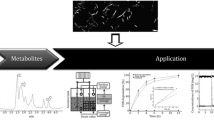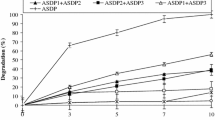Abstract
Three Pseudomonas species isolated from oil polluted soils in Lagos, Nigeria were studied for their pyrene degradation potentials. These isolates exhibited broad substrate specificities for hydrocarbon substrates including polycyclic aromatic hydrocarbons, petroleum fractions and chlorobenzoates. All three isolates tolerated salt concentrations of more than 3%. They resisted ampicillin, cenfuroxime, but susceptible to ofloxacin and ciprofloxacin. Pseudomonas sp. strain LP1 exhibited growth rates and pyrene degradation rates of 0.018 h−1 and 0.111 mg l−1 h−1 respectively, while P. aeruginosa strains LP5 and LP6 had corresponding values of 0.024, 0.082 and 0.017, 0.067 respectively. The overall respective percentage removal of pyrene obtained for strains LP1, LP5 and LP6 after a 30-day incubation period were 67.79, 66.61 and 47.09. Resting cell assay revealed that strain LP1 had the highest uptake rate. Strains LP1, LP5, and LP6 also used the ortho-cleavage pathway. Enzyme study confirmed activity of catechol 1,2-dioxygenase in all with values 0.6823, 0.9199, and 0.8344 μmol min−1 mg−1 respectively for LP1, LP3 and LP6. To the best of our knowledge, ours is the first report of pyrene-degraders from the sub-Saharan African environment.


Similar content being viewed by others
References
Adebusoye SA, Picardal FW, Ilori MO, Amund OO, Fuqua C, Grindle N (2007a) Growth on dichlorobipenyls with chlorine substitution on each ring by bacteria isolated from contaminated African soils. Appl Microbiol Biotechnol 74:484–492. doi:10.1007/s00253-006-0651-8
Adebusoye SA, Ilori MO, Amund OO, Teniola OD, Olatope SO (2007b) Microbial degradation of petroleum hydrocarbons in a polluted tropical stream. World J Microbiol Biotechnol 23:1149–1159. doi:10.1007/s11274-007-9345-3
Amund OO, Adewale AA, Ugoji EO (1987) Occurrence and characterisation of hydrocarbon utilising bacteria in Nigerian soils contaminated with spent motor oil Ind. J Microbiol 27:63–87
Barrow GI, Feltham RKA (1995) Cowan and Steel’s manual for identification of medical bacteria, 3rd edn. Cambridge, Cambridge University
Bauchop T, Elsden SR (1960) The growth of microorganisms in relation to their energy. J Gen Microbiol 23:457–459
Boldrin B, Thiem A, Fritzsche C (1993) Degradation of phenanthrene, fluorene, fluoranthene, and pyrene by Mycobacterium sp. Appl Environ Microbiol 59:1927–1930
Bouchez M, Blanchet D, Vandecasteele JP (1995) Degradation of polycyclic aromatic hydrocarbons by pure strains and defined strain associations: inhibition phenomena and cometabolism. Appl Microbiol Biotechnol 43:156–164. doi:10.1007/BF00170638
Bradford MM (1976) A rapid and sensitive method for the quantitation of microgram quantities of protein utilizing the principle of protein-dye binding. Anal Biochem 72:248–254. doi:10.1016/0003-2697(76)90527-3
Caldini G, Cenci G, Manenti R, Morozzi G (1995) The ability of an environmental isolate of Pseudomonas fluorescens to utilise chrysene and other four-ring polynuclear aromatic hydrocarbons. Appl Microbiol Biotechnol 44:225–229. doi:10.1007/BF00164506
Cerniglia CE (1992) Biodegradation of polycyclic aromatic hydrocarbons. Biodegradation 3:351–368. doi:10.1007/BF00129093
Chander Y, Kumar K, Goyal SM, Gupta SC (2005) Antibacterial activity of soil bound antibiotics. J Environ Qual 34:1952–1957. doi:10.2134/jeq2005.0017
Cheung P-Y, Kinkle BK (2001) Mycobacterium diversity and pyrene mineralisation in petroleum-contaminated soil. Appl Environ Microbiol 67:2222–2229. doi:10.1128/AEM.67.5.2222-2229.2001
Churchill SA, Harper JP, Churchill PF (1999) Isolation and characterisation of a Mycobacterium species capable of degrading three- and four-ring aromatic and aliphatic hydrocarbons. Appl Environ Microbiol 65:549–552
Das K, Mukherjee AK (2007) Differential utilization of pyrene as the sole source of carbon by Bacillus subtilis and Pseudomonas aeruginosa strain; role of biosurfactants in enhancing bioavailability. J Appl Microbiol 102:195–203. doi:10.1111/j.1365-2672.2006.03070.x
Dean-Ross D, Cerniglia CE (1996) Degradation of pyrene by Mycobacterium flavescens. Appl Microbiol Biotechnol 46:307–312. doi:10.1007/s002530050822
Derz K, Klinner U, Schupan I et al (2004) Mycobacterium pyrenivorans sp nov a novel polycyclic aromatic hydrocarbon degrading sp. Int J Syst Evol Microbiol 54:2313–2317. doi:10.1099/ijs.0.03003-0
Grosser RJ, Warshawsky D, Vestal JR (1991) Indigenous and enhanced mineralization of pyrene, benzo(a)pyrene and carbazole in soils. Appl Environ Microbiol 57:3462–3469
Heitkamp MA, Franklin W, Cerniglia CE (1988) Microbial metabolism of polycyclic aromatic hydrocarbons: isolation and characterization of a pyrene-degrading bacterium. Appl Environ Microbiol 54:2549–2555
Ilori MON, Amund OO (2000) Degradation of anthracene by bacteria isolated from oil polluted tropical soils. Z Naturforsch [C] 55:890–897
Johnsen AR, Wick LY, Harms H (2005) Principles of microbial PAH-degradation in soil. Environ Pollut 133:71–84. doi:10.1016/j.envpol.2004.04.015
Juhasz AL, Britz ML, Stanley GA (1997) Degradation of fluoranthene, pyrene, benz(a)anthracene and dibenz(a, h)anthracene by Burkholderia cepacia. J Appl Microbiol 83:189–198. doi:10.1046/j.1365-2672.1997.00220.x
Ka-Leung N, Neidle EL, Ornston CN (1990) Catechol and chlorocatechol 1, 2 dioxygenase. Methods Enzymol 188:122–126. doi:10.1016/0076-6879(90)88022-3
Kanaly R, Harayama S (2000) Biodegradation of high-molecular-weight polycyclic aromatic hydrocarbons by bacteria. J Bacteriol 182:2059–2067. doi:10.1128/JB.182.8.2059-2067.2000
Kastner M, Breuer-Jammali M, Mahro B (1994) Enumeration and characterisation of the soil microflora from hydrocarbon-contaminated soil sites able to mineralise polycyclic aromatic hydrocarbons. Appl Microbiol Biotechnol 41:267–273. doi:10.1007/BF00186971
Kastner M, Breuer-Jammali M, Mahro B (1998) Impact of inoculation protocols, salinity, and pH on the degradation of polycyclic aromatic hydrocarbons (PAHs) and survival of PAH-degrading bacteria introduced into soil. Appl Environ Microbiol 64:359–362
Kataeva TA, Golovleva LA (1990) Catechol 2, 3 dioxygenase. Methods Enzymol 188:115–121. doi:10.1016/0076-6879(90)88021-2
Kazunga C, Aitken MD (2000) Products from the incomplete metabolism of pyrene by polycyclic aromatic hydrocarbon-degrading bacteria. Appl Environ Microbiol 66:1917–1922. doi:10.1128/AEM.66.5.1917-1922.2000
Kim YH, Freeman JP, Moody JD et al (2005) Effects of pH on the degradation of phenanthrene and pyrene by Mycobacterium vanbaalenii PYR-1. Appl Microbiol Biotechnol 67:275–285. doi:10.1007/s00253-004-1796-y
Krivobok S, Kuony S, Meyer C et al (2003) Identification of pyrene-induced proteins in Mycobacterium sp. strain 6PYI: evidence of two ring-hydroxylating dioxygenase. J Bacteriol 185:3828–3841
Phillips TM, Seech AG, Lee H et al (2001) Colorimetric assay for lindane dechlorination by bacteria. J Microbiol Methods 47:181–188. doi:10.1016/S0167-7012(01)00299-8
Rothera ACH (1908) Note on the sodium nitroprussie reaction for acetone. J Physiol 37:491–492
Sarma PM, Bhattacharya D, Krishnan S et al (2004) Degradation of Polycyclic aromatic hydrocarbon by a newly discovered entereic bacteria Leclercia adecarboxylata. Appl Environ Microbiol 70:3163–3166. doi:10.1128/AEM.70.5.3163-3166.2004
Schneider J, Grosser R, Jayasimhulu K et al (1996) Degradation of pyrene, benzo(a)anthracene, and benzo(a)pyrene by Mycobacterium sp strain RJGII-135, isolated from a former coal gasification site. Appl Environ Microbiol 62:13–19
Stach JEM, Burns RG (2002) Enrichment versus biofilm culture: a functional and phylogenetic comparison of polycyclic aromatic hydrocarbon-degrading microbial communities. Environ Microbiol 4(3):159–182. doi:10.1046/j.1462-2920.2002.00283.x
Stanier RY, Palleroni NJ, Doudoroff M (1966) The aerobic Pseudomonads, a taxonomic study. J Gen Microbiol 43:159–271
Stringfellow WT, Aitken MD (1995) Competitive metabolism of naphthalene, methylnaphthalenes and fluorenes by phenanthrene-degrading pseudomonads. Appl Environ Microbiol 61:357–362
Thibault SI, Anderson M, Frankenberger WI Jr (1996) Influence of surfactants on pyrene desorption and degradation in soil. Appl Environ Microbiol 62:283–287
Trzesicka-Mlynarz D, Ward OP (1995) Degradation of polycyclic aromatic hydrocarbons (PAHs) by a mixed culture and its component pure cultures, obtained from PAH-contaminated soil. Can J Microbiol 41:470–476
Vila J, Lopez Z, Sabate J et al (2001) Identification of a novel metabolite of pyrene by Mycobacterium sp. strain API: action of the isolate on two and three ring polycyclic aromatic hydrocarbons. Appl Environ Microbiol 67:5497–5555
Wackett LP, Hershberger LCD (2001) Biocatalysis and biodegradation: microbial transformation of organic compounds. ASM Press, Washington
Walter U, Beyer M, Klein J et al (1991) Degradation of pyrene by Rhodococcus sp UW1. Appl Microbiol Biotechnol 34:671–676. doi:10.1007/BF00167921
Author information
Authors and Affiliations
Corresponding author
Rights and permissions
About this article
Cite this article
Obayori, O.S., Ilori, M.O., Adebusoye, S.A. et al. Pyrene-degradation potentials of Pseudomonas species isolated from polluted tropical soils. World J Microbiol Biotechnol 24, 2639–2646 (2008). https://doi.org/10.1007/s11274-008-9790-7
Received:
Accepted:
Published:
Issue Date:
DOI: https://doi.org/10.1007/s11274-008-9790-7




